There are many different levels of photographers who frequent this forum ranging from beginners to amateurs to professionals. Especially regarding the beginners, many of the threads tend to focus on gear. While this is understandable, I sometimes wonder if beginning photographers wouldn't be better served by threads explaining photographic principles.
In that vein, I'm creating this thread.
One of the common questions asked by beginning photographers in gear threads is "what should I buy so I can blur the background?"
This is actually a complex question. Background blur is influenced by focal length of the lens (actual focal length, *not* equivalent field-of-view between say a Dx sensor and FF sensor), aperture of the lens, and distance between the camera and the subject. Longer focal lengths, larger apertures, and shorter distances between camera-subject all create more blurred backgrounds.
A frequent response is to step back and use a longer focal length to achieve the same degree of background blur with a slower lens.
A somewhat related (but overlooked) question is: how do different camera-subject distances influence the overall composition of my images?
Going to attempt to provide examples highlighting all of these.
For all of these examples, the subject is the same: taken outside on my deck looking into my kitchen and dining room. I think this serves as a great subject since the images are framed by the door frame and cross-frames within the door. There is a foreground (the door frame), a middle-ground (some elements within the kitchen), and a background (the chair in my dining room). The relationship of all these elements will change among the following examples.
Aperture and sensor size/focal length
Here is a series where the field-of-view and camera-subject distance was kept relatively constant, but the depth-of-field varied depending on whether the images were shot with a DX or FF camera body and also on the aperture chosen. Nikon D3100 (DX body) with both an 18-200 lens and 24-70 lens. Nikon D800 (FF body) with the 24-70 lens. Also a Leica M (240) (FF body) with 50mm f/1.4 prime lens.
All shot at maximum aperture for a FF equivalent focal length of 50mm in low light. All shot at roughly 8 feet away. Specific camera settings included with each image. Tried to make the WB and exposure equal between the images in LR5. Not perfect though. All shot handheld from a prone position. The focus for all was on the frame within the glass panes in the door.
![13180366914_2bed0bae89_c.jpg]()
Nikon D3100 and 18-200 lens (version 1). 35mm, f/4.2, 1/4 sec., ISO 3200. Cat(s) snuck into this one
![13180223863_64997438d5_c.jpg]()
Nikon D3100 and 24-70 lens. 35mm, f/2.8, 1/8 sec., ISO 3200
![13181812244_847380419d_c.jpg]()
Nikon D800 and 24-70 lens. 50mm, f/2.8, 1/13 sec, ISO 3200
![13180103115_21df2d2059_c.jpg]()
Leica M (240) and 50mm f/1.4 lens. 50mm, f/1.4, 1/25 sec., ISO 800
The ability to isolate the subject (and thus blur the background) is clearly better with the faster lenses used at larger apertures (and in the case of the last 2 photos, also because they were shot on FF at 50mm and not at 35mm as on the DX body).
To achieve a similar field of view, cameras with smaller sensors (whether DX, P&S, or phone cameras) have to use a shorter focal length lens. This results in a much larger depth-of-field for a given aperture and camera-subject distance. This is optics/physics and can't be corrected by software or fixed in post.
Camera-subject distance and focal length
For this series, the camera-subject distance was changed (i.e. I zoomed with my feet). Especially for those who favor a prime, this is a common response to those that favor a zoom--just zoom with your feet. Note in these examples however that while you can achieve similar background blur by zooming out with your feet, the composition changes radically between the images--despite the fact that the field-of-view remains relatively constant:
![13232760905_2027198beb_c.jpg]()
D3100 and 18-200 lens. 18mm, f/4.5, 1/6 sec, ISO 3200. Shot at roughly 5 feet away. The degree of background blur is minimal because of the shorter focal length. This offset the closer camera-subject distance which would be expected to increase background blur for a given focal length and aperture.
![13255217733_7487aed366_c.jpg]()
Leica M (240) and 90mm f/2.5 lens. 90mm, f/4.0, 0.7 sec, ISO 800. Shot from roughly 13 feet away. The degree of background blur would have been accentuated had I used either a longer focal length shot from further away or opened up the lens from f/4 to its maximum of f/2.5.
The field-of-view is relatively constant between all of the images posted here. There are minor variations, but the door in the foreground is framed similarly. However, the relationship between the elements within the frame varies dramatically between the different camera-subject distances. Inclusion/exclusion of elements in the mid-field varies widely (extraneous kitchen elements in the wide shot) and the relative size of elements within the composition varies widely (note the apparent size of the background chair between all the camera/subject distances).
This is a fairly unique subject in that it makes the differences between camera-subject distance *very* obvious, but this phenomenon happens with *any* subject. Zooming with your feet changes the composition compared to standing still and changing the focal length with a zoom.
Didn't bother including examples above of how even slight lateral changes in shooting position radically changed the composition of the elements within the image (having the frames of the door line up with the left wall of my kitchen vs dividing the background):
![13334474164_ff26202007_c.jpg]()
FF body, 35mm, f/1.4, 1/30sec, ISO 2000
Just wanted to point out that there are several issues involved in "blurring the background." This effect is commonly achieved either with faster lenses, with stepping back and using a longer focal length, or by moving really close in the case of macro shots. These differences in shooting *aren't* equal regarding the final composition. None of them is necessarily better. For many images, the difference may not matter. But zooming with your feet *isn't* the same as remaining in place and using a different focal length. Most importantly as a teaching point, different camera-subject distances result in *very* different compositions regarding the relationship of the elements within the composition.
In that vein, I'm creating this thread.
One of the common questions asked by beginning photographers in gear threads is "what should I buy so I can blur the background?"
This is actually a complex question. Background blur is influenced by focal length of the lens (actual focal length, *not* equivalent field-of-view between say a Dx sensor and FF sensor), aperture of the lens, and distance between the camera and the subject. Longer focal lengths, larger apertures, and shorter distances between camera-subject all create more blurred backgrounds.
A frequent response is to step back and use a longer focal length to achieve the same degree of background blur with a slower lens.
A somewhat related (but overlooked) question is: how do different camera-subject distances influence the overall composition of my images?
Going to attempt to provide examples highlighting all of these.
For all of these examples, the subject is the same: taken outside on my deck looking into my kitchen and dining room. I think this serves as a great subject since the images are framed by the door frame and cross-frames within the door. There is a foreground (the door frame), a middle-ground (some elements within the kitchen), and a background (the chair in my dining room). The relationship of all these elements will change among the following examples.
Aperture and sensor size/focal length
Here is a series where the field-of-view and camera-subject distance was kept relatively constant, but the depth-of-field varied depending on whether the images were shot with a DX or FF camera body and also on the aperture chosen. Nikon D3100 (DX body) with both an 18-200 lens and 24-70 lens. Nikon D800 (FF body) with the 24-70 lens. Also a Leica M (240) (FF body) with 50mm f/1.4 prime lens.
All shot at maximum aperture for a FF equivalent focal length of 50mm in low light. All shot at roughly 8 feet away. Specific camera settings included with each image. Tried to make the WB and exposure equal between the images in LR5. Not perfect though. All shot handheld from a prone position. The focus for all was on the frame within the glass panes in the door.

Nikon D3100 and 18-200 lens (version 1). 35mm, f/4.2, 1/4 sec., ISO 3200. Cat(s) snuck into this one

Nikon D3100 and 24-70 lens. 35mm, f/2.8, 1/8 sec., ISO 3200
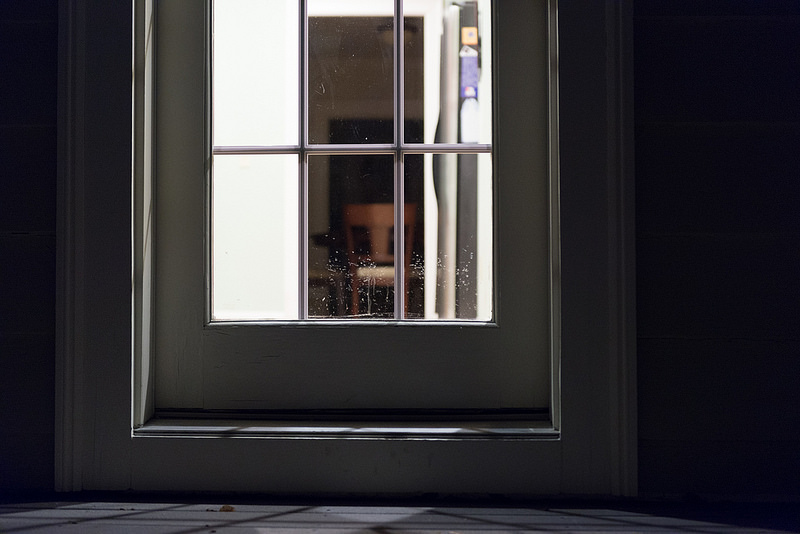
Nikon D800 and 24-70 lens. 50mm, f/2.8, 1/13 sec, ISO 3200
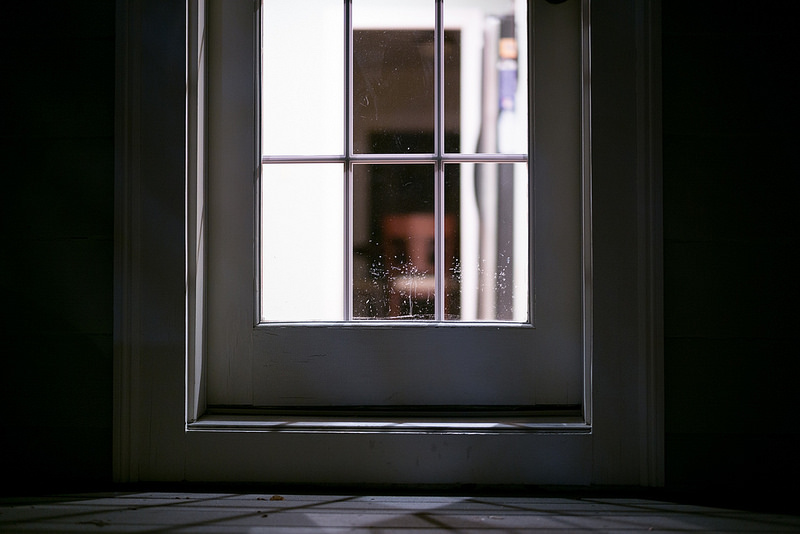
Leica M (240) and 50mm f/1.4 lens. 50mm, f/1.4, 1/25 sec., ISO 800
The ability to isolate the subject (and thus blur the background) is clearly better with the faster lenses used at larger apertures (and in the case of the last 2 photos, also because they were shot on FF at 50mm and not at 35mm as on the DX body).
To achieve a similar field of view, cameras with smaller sensors (whether DX, P&S, or phone cameras) have to use a shorter focal length lens. This results in a much larger depth-of-field for a given aperture and camera-subject distance. This is optics/physics and can't be corrected by software or fixed in post.
Camera-subject distance and focal length
For this series, the camera-subject distance was changed (i.e. I zoomed with my feet). Especially for those who favor a prime, this is a common response to those that favor a zoom--just zoom with your feet. Note in these examples however that while you can achieve similar background blur by zooming out with your feet, the composition changes radically between the images--despite the fact that the field-of-view remains relatively constant:
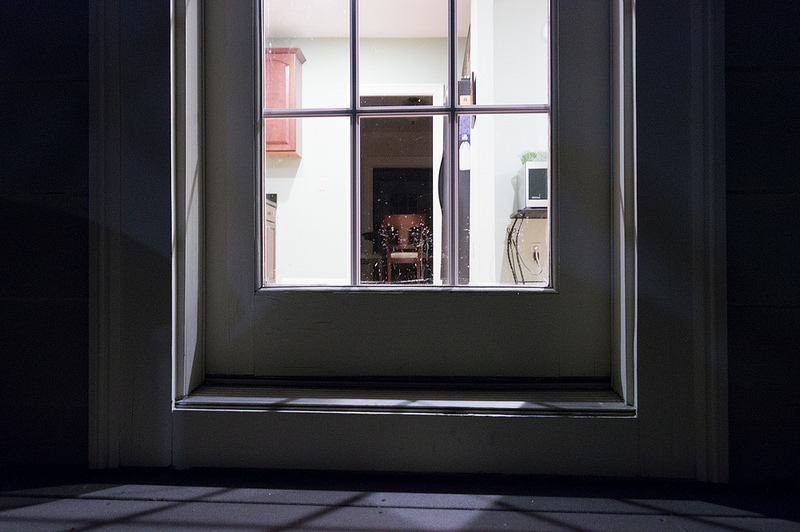
D3100 and 18-200 lens. 18mm, f/4.5, 1/6 sec, ISO 3200. Shot at roughly 5 feet away. The degree of background blur is minimal because of the shorter focal length. This offset the closer camera-subject distance which would be expected to increase background blur for a given focal length and aperture.
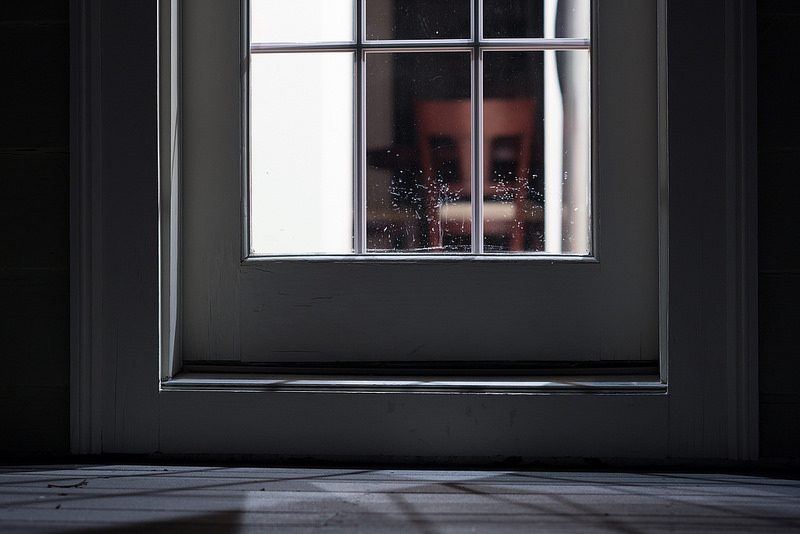
Leica M (240) and 90mm f/2.5 lens. 90mm, f/4.0, 0.7 sec, ISO 800. Shot from roughly 13 feet away. The degree of background blur would have been accentuated had I used either a longer focal length shot from further away or opened up the lens from f/4 to its maximum of f/2.5.
The field-of-view is relatively constant between all of the images posted here. There are minor variations, but the door in the foreground is framed similarly. However, the relationship between the elements within the frame varies dramatically between the different camera-subject distances. Inclusion/exclusion of elements in the mid-field varies widely (extraneous kitchen elements in the wide shot) and the relative size of elements within the composition varies widely (note the apparent size of the background chair between all the camera/subject distances).
This is a fairly unique subject in that it makes the differences between camera-subject distance *very* obvious, but this phenomenon happens with *any* subject. Zooming with your feet changes the composition compared to standing still and changing the focal length with a zoom.
Didn't bother including examples above of how even slight lateral changes in shooting position radically changed the composition of the elements within the image (having the frames of the door line up with the left wall of my kitchen vs dividing the background):
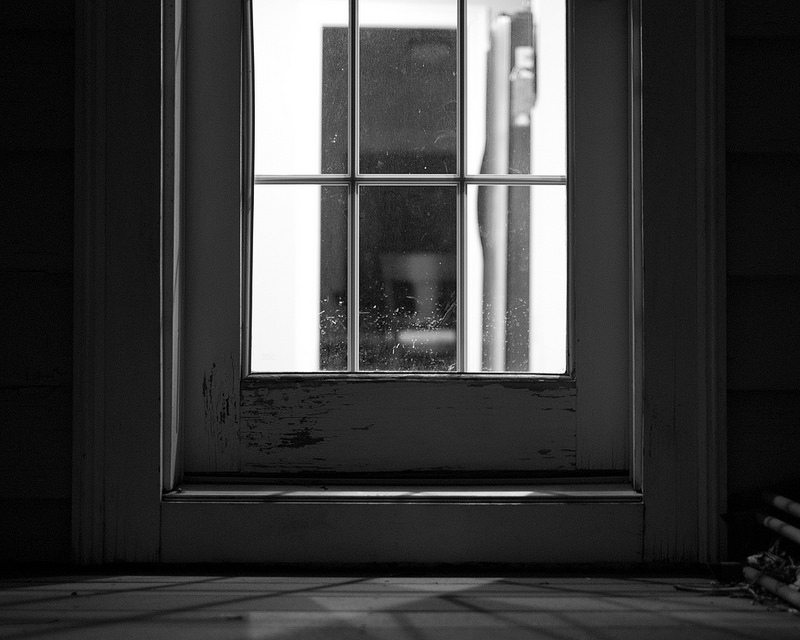
FF body, 35mm, f/1.4, 1/30sec, ISO 2000
Just wanted to point out that there are several issues involved in "blurring the background." This effect is commonly achieved either with faster lenses, with stepping back and using a longer focal length, or by moving really close in the case of macro shots. These differences in shooting *aren't* equal regarding the final composition. None of them is necessarily better. For many images, the difference may not matter. But zooming with your feet *isn't* the same as remaining in place and using a different focal length. Most importantly as a teaching point, different camera-subject distances result in *very* different compositions regarding the relationship of the elements within the composition.
Last edited:

